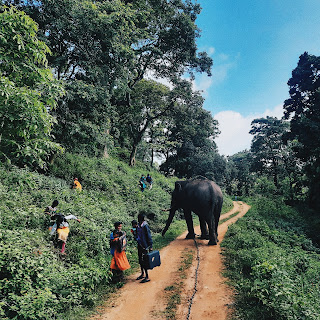For Hornbills: Sowing Seeds to Sustain Stories
Under a hornbill's nest, we found a treasure trove of regurgitated seeds.
Hornbills are magnificent creatures that find importance in ecology as well as culture. Nothing has been more exciting lately than getting opportunities to witness their nesting behaviour. Hornbills nest in tree cavities, but there's something incredibly unique about this. Hornbills are monogamous, and while breeding, the male and female scour the forest together for a perfect cavity. When it's time to lay eggs, the female enters the cavity and seals the opening with mud and faeces, leaving only a small opening. She also sheds all her feathers, leaving her unable to fly until her feathers grow back. As the eggs hatch, the male brings fruits for the female, and later for the chicks too. After a few weeks, when the female's flying feathers grow back, she breaks open the nest and reseals it, joining the male in feeding the chicks, who remain inside for some more time. Hornbills eat fruits and regurgitate the seeds, dispersing them across the forest as they forage.
 |
| A wreathed hornbill's active nest in a tree cavity. |
This fascinating behaviour made me wonder if there were cultures and communities around the world that recognised this behaviour and imagined explanations of it through stories. And of course, I found one! In contrast to the romanticism and faith-symbolism that this behaviour gets from most natural history enthusiasts, for the people of Matabelaland in Zimbabwe, infidelity is its root. According to their stories, hornbills used to make nests with twigs just like other birds. However, during the hatching period, as the male would fly around the forest searching for fruits, the female, instead of hatching the eggs, grew to like another male and would fly off to spend time with him. When her mate discovered that she had been doing this, he also realised that the eggs were damaged and would never hatch. Enraged, when the female laid eggs again, the male sealed her in a tree cavity until the eggs had hatched. This practice continues to this day.
From another part of Africa, Liberia, I found a story about seed dispersal by the hornbill. Nymo, a recurrent (presumably human) character in Liberian folklore, and the hornbill go to the forest to eat ripe nuts from a palm tree. While Nymo eats the pulp and discards the seeds and shells, hornbill swallows it all up. Later, Nymo meets the animals of the forest and informs them that the hornbill's tummy is full of palm nuts and seeds, and asks them to take him to the river and throw up the seeds if they wanted to avoid misfortune. However, they pay no heed to his advice. Later, as the hornbill flies about, he drops these seeds, and a forest of palm grows. From these palm trees, fishermen get material to make fishlines, hunters make palm oil and trade it for guns and pellets, and boys ("Small-Boy") get fibre to set bird traps. When a fish is caught in the fisherman's nest, it cries out for help; when a deer is hit by a hunter's pellet, it cries out in pain; when some birds are caught in the boys' trap, they too cry out helplessly - but Nymo says to all of them, "Didn't I warn you that when the hornbill drops all those seeds, it will bring us trouble? You didn't listen to me, what can we do now?" A story that reflects knowledge of the hornbill's feeding behaviour, recognises that it helps grow and sustain forests, and that it indirectly helps humans to sustain themselves - how awesome!
If the male hornbill is killed in the first few days of nesting, the female, who would be unable to fly at least for a few weeks, could starve to death. As forests disappear, it gets more difficult for hornbills to find trees which have perfect cavities for nesting, which is crucial to ensure that the female and her chicks survive the hatching and fledging periods. As hornbills disappear, fewer seeds are sown in the forest, and gradually, the forest disappears too.
 |
| The magnificent tree that is home to the wreathed hornbill female and perhaps, chicks. |
While they had mostly disappeared from most forests in the North East, the forests of Pakke Tiger Reserve were one of the last remaining safe havens for hornbills, but rampant hunting threatened their numbers there too. Scientists and conservationists from the Nature Conservation Foundation then started the Hornbill Nest Adoption Program - with a system that enabled former hunters to earn a living and dedicate their efforts to these birds by watching over their nests, recording their activity, and contributing to data about their distribution, seed dispersal, and behaviour. You can support these "Nest Protectors" by donating to the program. You can also contribute to country-wide data about hornbills by recording your hornbill sightings on the HornbillWatch website.
With hope, I turn to stories - stories born out of cultures that understood hornbills in the past, and stories from a present time of efforts to revive their presence around us, for people and children to keep watching, understanding, and imagine stories about them for years to come.



I love these stories, especially the one from Liberia! super interesting how the ecological knowledge of places and knowledge of species are embedded in them. And yes, like you, I turn to stories for hope for the future too.
ReplyDeleteThanks for reading, Ro! I'm glad. :) Truly, it's so fascinating also how the same behaviour gets associated with different anthropomorphic emotions, relationships, and behaviour around the world. I wonder what cultural and ecological changes across these landscapes influenced these changes in stories and perspectives. Stories hold even greater stories within them. :))
Delete